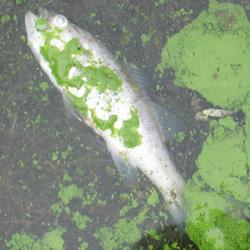Toxins Produced by Molds Measured in U.S. Streams
Stream Mycotoxin Concentrations were Highest During Spring Snowmelt
A team of scientists from the U.S. Geological Survey (USGS) and the Agroscope Reckenholz-Tanikon Research Station, Switzerland, found that some mycotoxins are common in U. S. stream waters. Mycotoxins are toxic compounds produced by molds (fungi) that can cause disease and even death in humans and animals. Mycotoxins can grow on a wide variety of crops.

The scientists collected 116 water samples from 32 streams and the discharge from three wastewater treatment plants. They analyzed the samples for 33 mycotoxins, and 9 were detected. At least one mycotoxin was detected in 109 of the 116 samples. The concentrations detected were primarily in the range of a part per trillion (nanograms per liter [ng/L]) to a part per billion (micrograms per liter [µg/L]) and were generally less than 50 ng/L. However, concentrations exceeding 1 mg/L were measured in agricultural settings during spring snowmelt and in wastewater treatment plant effluent.
Deoxynivalenol, the most frequently detected mycotoxin, was detected in 77 percent of the samples, followed by nivalenol (59 percent), and beauvericin (43 percent). Three of the mycotoxins are known estrogenic compounds (zearalenone, α-zearalenol, and β-zearalenol). One or more of these three compounds were detected in 43 percent of the samples, and their maximum concentrations were substantially higher than observed in previous research.
This study is the broadest evaluation conducted to date of the spatial and temporal occurrence of mycotoxins in U.S. streams. The results suggest that both diffuse and point sources are important environmental pathways for mycotoxin transport to streams. The study was supported by the USGS Toxic Substances Hydrology Program and the Swiss Federal Office for the Environment.
Related science listed below.
New Study Measures Crop Bactericide, Nitrapyrin, in Iowa Streams
U.S. Geological Survey Scientists Complete First Systematic Regional Survey of Algal Toxins in Streams of the Southeastern United States
Neuroactive Pharmaceuticals in Minnesota Rivers
Biological Activity of Steroid Hormones in U.S. Streams
Chemical Combo and Intersex Fish Found at Smallmouth Bass Nesting Sites
Algal Blooms Consistently Produce Complex Mixtures of Cyanotoxins and Co-Occur with Taste-and-Odor Causing Compounds in 23 Midwestern Lakes
Antidepressants in Stream Waters! Are They in the Fish Too?
Manufacturing Facilities Release Pharmaceuticals to the Environment
Glyphosate Herbicide Found in Many Midwestern Streams, Antibiotics Not Common
National Reconnaissance of Pharmaceuticals, Hormones and Other Organic Wastewater Contaminants in U.S. Streams is Making an Impact
National Reconnaissance of Pharmaceuticals, Hormones, and Other Organic Wastewater Contaminants in Streams Named as One of the Top 100 Science Stories of the Year
Related publications listed below.
Mycotoxins: diffuse and point source contributions of natural contaminants of emerging concern to streams Mycotoxins: diffuse and point source contributions of natural contaminants of emerging concern to streams
A team of scientists from the U.S. Geological Survey (USGS) and the Agroscope Reckenholz-Tanikon Research Station, Switzerland, found that some mycotoxins are common in U. S. stream waters. Mycotoxins are toxic compounds produced by molds (fungi) that can cause disease and even death in humans and animals. Mycotoxins can grow on a wide variety of crops.

The scientists collected 116 water samples from 32 streams and the discharge from three wastewater treatment plants. They analyzed the samples for 33 mycotoxins, and 9 were detected. At least one mycotoxin was detected in 109 of the 116 samples. The concentrations detected were primarily in the range of a part per trillion (nanograms per liter [ng/L]) to a part per billion (micrograms per liter [µg/L]) and were generally less than 50 ng/L. However, concentrations exceeding 1 mg/L were measured in agricultural settings during spring snowmelt and in wastewater treatment plant effluent.
Deoxynivalenol, the most frequently detected mycotoxin, was detected in 77 percent of the samples, followed by nivalenol (59 percent), and beauvericin (43 percent). Three of the mycotoxins are known estrogenic compounds (zearalenone, α-zearalenol, and β-zearalenol). One or more of these three compounds were detected in 43 percent of the samples, and their maximum concentrations were substantially higher than observed in previous research.
This study is the broadest evaluation conducted to date of the spatial and temporal occurrence of mycotoxins in U.S. streams. The results suggest that both diffuse and point sources are important environmental pathways for mycotoxin transport to streams. The study was supported by the USGS Toxic Substances Hydrology Program and the Swiss Federal Office for the Environment.
Related science listed below.
New Study Measures Crop Bactericide, Nitrapyrin, in Iowa Streams
U.S. Geological Survey Scientists Complete First Systematic Regional Survey of Algal Toxins in Streams of the Southeastern United States
Neuroactive Pharmaceuticals in Minnesota Rivers
Biological Activity of Steroid Hormones in U.S. Streams
Chemical Combo and Intersex Fish Found at Smallmouth Bass Nesting Sites
Algal Blooms Consistently Produce Complex Mixtures of Cyanotoxins and Co-Occur with Taste-and-Odor Causing Compounds in 23 Midwestern Lakes
Antidepressants in Stream Waters! Are They in the Fish Too?
Manufacturing Facilities Release Pharmaceuticals to the Environment
Glyphosate Herbicide Found in Many Midwestern Streams, Antibiotics Not Common
National Reconnaissance of Pharmaceuticals, Hormones and Other Organic Wastewater Contaminants in U.S. Streams is Making an Impact
National Reconnaissance of Pharmaceuticals, Hormones, and Other Organic Wastewater Contaminants in Streams Named as One of the Top 100 Science Stories of the Year
Related publications listed below.












